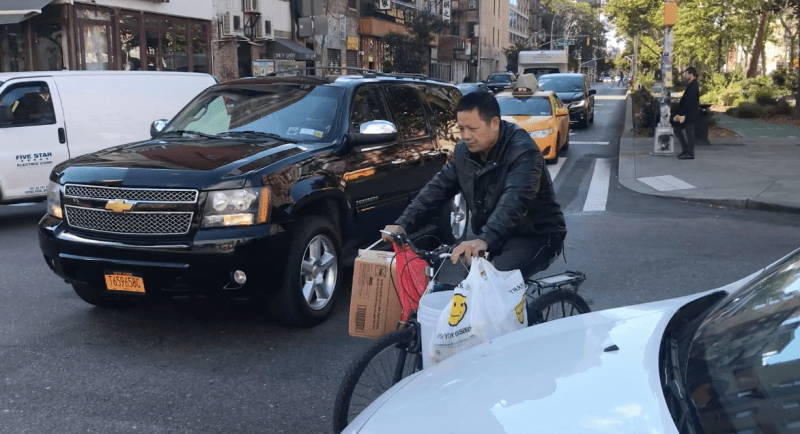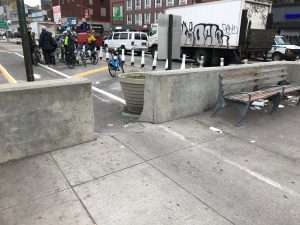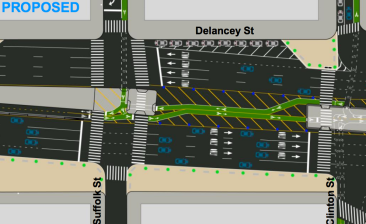UPDATE: DOT Says It Will Fix Screwed-Up Delancey and Allen Intersection

The intersection of Delancey and Allen streets is now officially a s#!tshow, thanks to the Department of Transportation, which promises more work will be done to ease cyclists’ concerns.
Members of the #bikenyc army noticed this week that workers had installed a raised safety island in the large intersection.
. @StreetsblogNYC sorry if you've covered this before but what's with this new cement island on Allen and Delancey? Currently all bikers are being forced into uptown traffic. pic.twitter.com/Pc74hnaSjS
— Count Mapula (@deralect) October 23, 2018
The apparent goal was to give cyclists a place to wait at the western terminus of the forthcoming two-way bike path from the Williamsburg Bridge on the south side of the Delancey Street median. Cyclists will eventually be able to go north or south on Allen Street from that island and, in theory, avoid conflicts with drivers or pedestrians.
Instead, the DOT has created an area in the middle of the intersection where eastbound drivers on Delancey Street wait when they hit the red light at Allen Street. Before, drivers typically waited on the west side of Allen Street before entering the intersection, lest they be “blocking the box.” Now, the raised island makes them feel comfortable sitting at the light in the middle of the intersection because they’re only blocking a bike lane, after all. And they’re not blocking the box. They are the box.
It’s a bit confusing to describe, but these pictures tell the whole story. Here’s what the intersection looked like before:
Sure, sometimes drivers would block the box, but mostly, it was empty when the signal was green for northbound cars and cyclists. But now…
…cars waiting for the red light block the bike lane.
As a result, cyclists who have the green are forced into traffic, as this video shows:
Even when they’re not pushed into the traffic because of drivers blocking the new box, many cyclists don’t know what to make of the raised area — especially since there’s a bollard sitting in the middle of the supposed bike lane…
Pedestrians are also adversely affected by all the drivers who are box-blocking. And many drivers can’t get through the intersection anymore.
I wouldn’t have believed that anyone working for the city Department of Transportation could install something so ineffective — but it’s even more galling because the new construction so willfully ignores the agency’s own presentation about what it planned to do on the site.
Last year, the DOT showed off the design at left to Community Board 3. Note the green box in the center of the intersection. That zone was clearly intended to provide a safe waiting area for cyclists, but did not apparently require a raised area. And the north and south bike lanes would skirt it.
The accompanying text merely said the agency would “add [a] protected bike box in the intersection” because such paint “facilitates safe bike movements.” It didn’t say anything about bollards or major infrastructure that would discourage cyclists while also emboldening drivers.
After the initial publication of this story, DOT spokesman Chris Browne offered a very full explanation. Here it is, in full:
Thanks for your inquiry about DOT’s new “bike island” at Delancey and Allen Streets, a new and innovative intersection design that will be key in our plans to address the upsurge in cycling over the Williamsburg Bridge during the L train tunnel shutdown next year. Your article’s focus on the north-south movement fails to effectively highlight how this design allows cyclists to safely and efficiently connect from the not-yet-complete two-way path on Delancey to existing infrastructure on Pike/Allen — avoiding an otherwise awkward and slow crossing that would have increased conflicts with vehicles and pedestrians.
While the island itself has just been finished this past week, the intersection is nowhere near complete. We expect the following work to be wrapped up in the weeks ahead:
- New signals installed on the island itself and adjustments to signs and signal timing to discourage turning vehicles from blocking the intersection
- Installation of planned markings that clearly identify a path of safe travel for cyclists (between new bollards) while also discouraging riders from going around the island
- Evaluation of curb slope
In short, more to come. Even after it is complete, the island will certainly require some time to adjust. And while our original presentation showed paint and delineators, our engineers felt that a raised space with bollards would better protect cyclists at an intersection where two truck routes intersect and through which dozens of new MTA Select Bus Service buses will turn — as they carry thousands more displaced L riders each day starting next spring.
In the coming weeks, we ask patience from cyclists who now use the intersection, and urge them to exercise extra caution as we finish our work. Next spring, DOT expects thousands of new, less experienced cyclists to join those veteran Lower East Side riders in the Delancey/Allen intersection each day — with perhaps more than a dozen cyclists stopped for turns on the island at any given time. The safety of all of those cyclists remains paramount in our planning.
That answer explains some of the things from my full video, which was made earlier in the day and is still worth enjoying:




